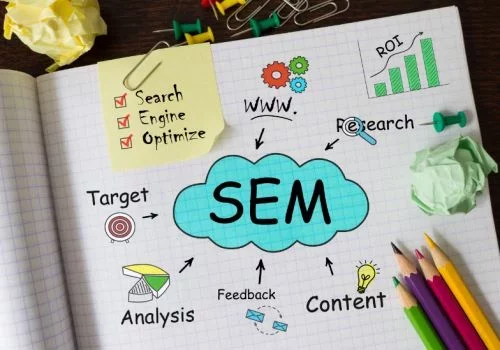Search Engine Marketing: Driving Visibility and Growth Fast
Unlock the power of Search Engine Marketing or Paid Advertisement. Learn strategies, platforms, and metrics to elevate your organisation’s digital presence and maximise ROI.
Table of Contents

Imagine having the power to instantly connect with customers who are actively seeking your products or services.
Welcome to the dynamic realm of Search Engine Marketing (Paid Ads) – the digital marketer’s secret weapon.
In the extreme competitive online landscape, SEM is the turbocharge your business needs to skyrocket its visibility and laser-target ideal customers. By strategically placing paid ads on search engine results pages, SEM puts your brand front and center, right when potential buyers are poised to make decisions.
It’s not just marketing; it’s precision-guided customer acquisition at its finest.
Unlike Search Engine Optimisation (SEO), which focuses on improving organic search rankings through unpaid methods, SEM involves bidding on keywords and paying for prominent ad placements. This distinction allows businesses to gain immediate visibility, even in highly competitive markets where organic rankings may take months or years to achieve.
In an era where Google has become our go-to oracle, SEM is your secret weapon to rise above the noise. It’s not just about being seen—it’s about being seen by the right people at the right time. By mastering SEM, you’re not just throwing a wider net; you’re precision-targeting the big fish.
In today’s fiercely competitive market, SEM isn’t just an option—it’s your ticket to staying relevant, captivating your audience, and getting ahead of your competitor.
Core Components of Search Engine Marketing
Search Engine Marketing is a dynamic field with several key components that work together to create successful campaigns.
Let’s explore the core elements that make SEM an effective digital marketing strategy.
Paid Search Ads
Paid search ads are the backbone of SEM, appearing at the top of search engine results pages (SERPs) when users search for relevant keywords.

These ads come in various formats:
- Text Ads: The most common type, consisting of a headline, description, and URL.
- Shopping Ads: Visual product listings that appear in search results, showcasing product images, prices, and merchant information.
- Display Ads: Image-based advertisements that appear on websites within a search engine’s advertising network.
These ads offer businesses immediate visibility and the ability to target specific audiences based on search intent, making them a powerful tool for driving traffic and conversions.
Ad Auctions and Bidding
Behind every paid search ad is a complex auction system that determines which ads appear and in what order.
Here’s how it works:
- Advertisers bid on keywords relevant to their business.
- When a user searches for a keyword, an instantaneous auction occurs.
- The auction considers factors such as bid amount, ad quality, and relevance.
The bidding process is dynamic, allowing advertisers to adjust their strategies in real time. Factors influencing ad placement and costs include:
- Bid amount
- Ad quality and relevance
- Expected click-through rate (CTR)
- Landing page experience
This system ensures that the most relevant and high-quality ads have the best chance of appearing in top positions, benefiting both users and advertisers.
Quality Score and Ad Rank
Quality Score is a crucial metric in SEM that measures the overall quality and relevance of your ads. It’s determined by several factors:
- Ad relevance to the search query
- Expected click-through rate
- Landing page experience
A high-Quality Score can lead to:
- Lower costs per click (CPC)
- Better ad positions
- Increased ad visibility
Ad Rank determines the position of your ad on the SERP. It’s calculated using:
- Your bid amount
- Your Quality Score
- The expected impact of ad extensions and other ad formats
One should focus on refining these core elements to create effective SEM campaigns.
Doing so will help reach the right audience, drive valuable traffic, and achieve a better return on investment (ROI). Remember that succeeding in SEM is more than just outbidding competitors; it’s about creating ads that truly resonate with users and align with what they’re searching for.
Platforms for Search Engine Marketing

In the world of Search Engine Marketing, choosing the right platform can make a significant difference in your campaign’s success. Let’s explore the major players in the SEM arena and their unique offerings.
Google Ads: The Titan of SEM
Google Ads reigns supreme in the SEM landscape, and for good reason:
- Massive Reach: With over 5.6 billion searches per day, Google offers unparalleled access to potential customers.
- Advanced Targeting: Leverage demographic, geographic, and behavioural data to reach your ideal audience.
- Diverse Ad Formats: From text and display ads to video and shopping ads, Google provides a variety of options to showcase your products or services.
Tips for Google Ads Success:
- Conduct thorough keyword research
- Create compelling ad copy with clear calls-to-action
- Optimise landing pages for conversions
- Regularly monitor and adjust your campaigns based on performance data
Microsoft Advertising: The Underdog with Potential
While often overshadowed by Google, Microsoft Advertising (formerly Bing Ads) offers unique advantages:
- Less Competition: Lower competition can mean lower costs per click and potentially higher ROI.
- Demographic Edge: Microsoft Advertising users tend to be older and have higher household incomes, which may align well with certain business targets.
- Integration with Microsoft Products: Seamless integration with tools like LinkedIn for B2B targeting.
Microsoft Advertising vs. Google Ads
| Feature | Microsoft Advertising | Google Ads |
| Market Share | Smaller | Larger |
| Cost per Click | Generally lower | Often higher |
| Targeting Options | Good, with unique LinkedIn integration | Extensive |
| Ad Formats | Similar to Google, with some variations | Most diverse |
Each of these platforms has its strengths, and the best choice depends on your specific business goals, target audience, and budget. Many successful SEM strategies involve a mix of platforms to maximize reach and efficiency.
Remember, regardless of the platform you choose, the key to SEM success lies in continuous testing, learning, and optimisation. Stay agile, monitor your metrics closely, and be ready to adapt your strategy as you gather more data about what works best for your business.
Search Engine Marketing Strategies
Effective Search Engine Marketing strategies are crucial for businesses looking to maximise their online visibility and drive targeted traffic. Let’s explore some key components that can elevate your SEM campaigns.

Keyword Research and Selection
The foundation of any successful SEM campaign lies in thorough keyword research and selection. Here are some techniques to enhance your keyword strategy:
- Long-tail keywords: Focus on specific, longer phrases that have lower competition but higher intent.
- Competitor analysis: Examine your competitors’ keywords to identify opportunities and gaps.
- Search intent alignment: Ensure your keywords match the user’s search intent (informational, navigational, or transactional).
Useful tools for keyword research include:
- Google Keyword Planner
- SEMrush
- Ahrefs
- Moz Keyword Explorer
These tools provide valuable insights into search volume, competition, and related keywords, helping you make data-driven decisions.
Ad Creation and Optimisation
Creating compelling ad copy is essential for standing out in crowded search results. Here are some tips to improve your ad performance:
- Highlight unique selling points: Clearly communicate what sets your product or service apart.
- Use strong calls-to-action: Encourage users to take the desired action with clear, compelling CTAs.
- Implement ad extensions: Utilise site links, callouts, and structured snippets to provide more information and increase ad real estate.
For ad optimisation:
- Regularly A/B test different ad variations
- Monitor and adjust bids based on performance
- Optimise for quality scores by improving ad relevance and landing page experience
- Targeting and Audience Segmentation
Effective targeting ensures your ads reach the right people at the right time.
Consider these methods:
- Geographic targeting: Focus on specific locations relevant to your business.
- Device targeting: Tailor ads for desktop, mobile, or tablet users.
- Demographic targeting: Target based on age, gender, income, or education level.

Audience segmentation is crucial in SEM as it allows for more personalised and relevant messaging.
By dividing your audience into distinct groups based on shared characteristics, you can:
- Create more targeted ad copy
- Adjust bids for high-value segments
- Develop custom landing pages for specific audience groups
Successful SEM strategies require continuous monitoring and optimisation. Stay agile, keep testing, and always be ready to adapt your approach based on performance data and market changes.
Measuring Search Engine Marketing Success
To truly gauge the effectiveness of your SEM efforts, it’s crucial to track key performance indicators (KPIs) and analyse your return on investment (ROI). Let’s explore the essential metrics and methods for measuring SEM success.

Key Performance Indicators (KPIs)
Tracking the right KPIs is vital for understanding your SEM campaign’s performance. Here are some critical metrics to monitor:
- Click-Through Rate (CTR): Measures the percentage of users who click on your ad after seeing it. A higher CTR indicates that your ad is relevant and compelling to your target audience.
- Conversion Rate: The percentage of users who complete a desired action (e.g., purchase, sign-up) after clicking your ad. This metric helps assess the effectiveness of your landing pages and overall user experience.
- Quality Score: A metric used by search engines to evaluate the relevance and quality of your ads and keywords. A higher Quality Score can lead to better ad positions and lower costs.
- Cost Per Click (CPC): The average amount you pay for each click on your ad. Monitoring CPC helps optimise your budget allocation and bidding strategies.
To track these KPIs effectively, utilise tools like Google Analytics, Google Ads, and Microsoft Advertising. These platforms provide comprehensive data and insights to help you analyse your SEM performance.
Conversion Tracking and ROI
Measuring conversions and calculating ROI are crucial for determining the success of your SEM campaigns:
- Implement Conversion Tracking: Set up conversion tracking in your advertising platforms to monitor specific actions users take after clicking your ads. This may include purchases, form submissions, or newsletter sign-ups.
- Assign Value to Conversions: Determine the monetary value of each conversion type to accurately calculate your ROI.
- Calculate ROI: Use the following formula to determine your SEM campaign’s ROI: ROI = (Revenue – Cost) / Cost x 100%
For example, if you spent $1,000 on a campaign that generated $5,000 in revenue:
ROI = ($5,000 – $1,000) / $1,000 x 100% = 400%
- Analyse ROI by Campaign: Break down your ROI calculations by individual campaigns, ad groups, and keywords to identify top performers and areas for improvement.
By consistently monitoring these KPIs and calculating your ROI, you can make data-driven decisions to optimise your SEM strategies, allocate your budget more effectively, and ultimately drive better results for your business.
Remember, successful SEM is an ongoing process of testing, analysing, and refining. Regularly review your performance metrics and be prepared to adjust your approach based on the insights you gain.
Challenges and Considerations of Search Engine Marketing
While Search Engine Marketing offers tremendous opportunities for businesses, it also comes with its own set of challenges and considerations.
Let’s explore two critical areas that require careful attention: budget management and ad compliance.
Budget Management
Effective budget allocation is crucial for maximising the return on your SEM investment.
Here are some strategies to optimise your spending:

- Start Small, Scale Gradually: Begin with a modest budget to test and learn, then incrementally increase spending as you identify successful campaigns.
- Use Bid Adjustments: Leverage bid adjustments for factors like device, location, and time of day to allocate more budget to high-performing segments.
- Implement Ad Scheduling: Focus your budget on times when your target audience is most likely to convert.
- Monitor Quality Score: Improve your Quality Score to lower costs per click and stretch your budget further.
- Utilise Automated Bidding: Consider using machine learning-powered bidding strategies to optimise for conversions or conversion value.
Managing costs while maximising performance requires a delicate balance. Regularly review your campaigns to:
- Pause underperforming keywords or ads
- Refine your targeting to reduce wasted spend
- Experiment with different ad formats to find the most cost-effective options
Remember, the goal is not always to spend less, but to spend smarter for better results.
Ad Compliance and Legal Considerations
Navigating the complex landscape of ad compliance and legal requirements is essential for sustainable SEM success.

Here are some key areas to focus on:
Common Compliance Issues:
- Trademark Infringement: Avoid using competitors’ trademarked terms in your ad copy or keywords without permission.
- False or Misleading Claims: Ensure all claims in your ads are truthful and can be substantiated.
- Restricted Content: Be aware of platform-specific policies regarding sensitive topics like alcohol, gambling, or pharmaceuticals.
Legal Considerations:
- Privacy Laws: Comply with PDPA regulations when collecting and using user data for targeting.
- Industry-Specific Regulations: Adhere to sector-specific rules, such as financial services or healthcare advertising guidelines.
- Accessibility: Ensure your ads and landing pages are accessible to users with disabilities to avoid potential legal issues.
To navigate these challenges:
- Stay Informed: Regularly review platform policies and relevant laws.
- Implement Review Processes: Establish internal checks to ensure all ads meet compliance standards before publication.
- Use Disclaimer Language: When necessary, include appropriate disclaimers in your ad copy or landing pages.
- Seek Legal Counsel: For complex cases or high-stakes campaigns, consult with legal experts specialising in digital advertising.
To create more effective, compliant, and sustainable SEM campaigns, address these challenges and considerations directly. Although these elements may seem overwhelming, they are essential for gaining trust from your audience and the advertising platforms.
Ignite Your Online Presence: The Power of Search Engine Marketing
As we’ve explored throughout this article, Search Engine Marketing is a powerful tool in the digital marketer’s arsenal. It combines the precision of targeted advertising with the vast reach of search engines, offering businesses a unique opportunity to connect with their audience at crucial decision-making moments.
Key takeaways from our discussion include:
- The critical role of SEM in driving qualified traffic and leads
- The importance of keyword research and ad copy optimization
- The power of data-driven decision-making through analytics and A/B testing
- The necessity of continuous refinement and adaptation in SEM strategies
If businesses leverage these components effectively, they can increase their visibility, drive meaningful conversions, and achieve substantial ROI.
In a competitive market, SEM is no longer optional—it’s essential for businesses looking to thrive online. Regardless of business size, SEM can be tailored to meet your specific goals and budget.
Elevate Your Business with Websparks’ SEM Expert Strategies
Ready to supercharge your online presence?
At Websparks, we specialise in crafting bespoke SEM strategies that deliver results.
Our team of experts can help you:
- Develop targeted campaigns that reach your ideal customers
- Optimise your ad spend for maximum ROI
- Stay ahead of the competition with cutting-edge SEM techniques
- Integrate SEM with your broader digital marketing strategy
Don’t let your competitors outshine you in search results.
Get in touch with Websparks today to discover how our SEM services can propel your business to new heights.
Let’s work together to create a powerful SEM strategy that not only increases your visibility but also drives real business growth.


